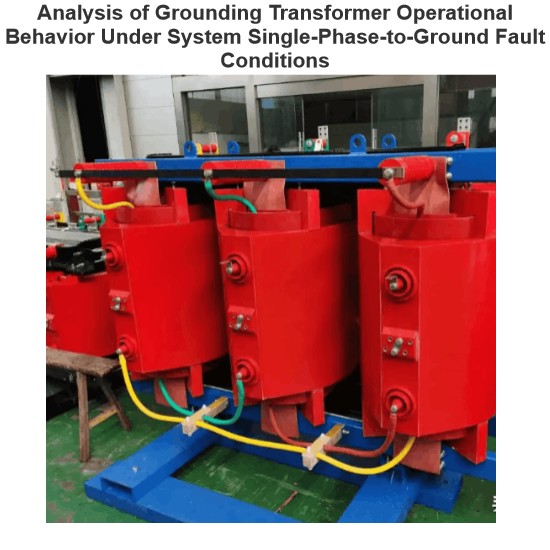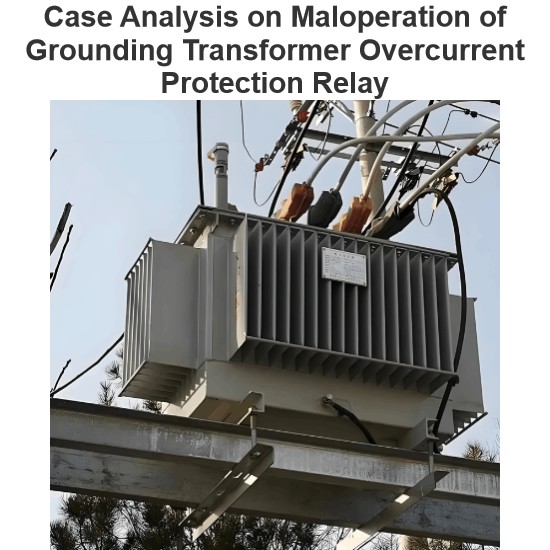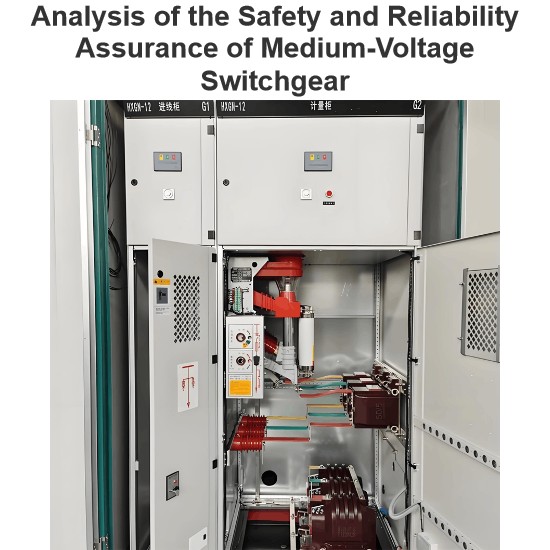Fault Analysis of 35kV Outdoor Vacuum Circuit Breaker Pillar Porcelain Sleeve
The ZW7 - 40.5 outdoor vacuum circuit breaker uses vacuum as the arc - extinguishing medium. The moving end of the arc - extinguishing chamber is connected to the output shaft of the operating mechanism through a crank arm and an insulating tie - rod. The overall structure of the circuit breaker is of the porcelain - bushing pillar type.
The upper porcelain bushing serves as the arc - extinguishing chamber porcelain bushing, and the lower one acts as the supporting porcelain bushing. The three - phase porcelain bushings are installed on a frame, and the three - phase current transformers are mounted inside the lower supporting porcelain bushings and connected to the main circuit of the circuit breaker (as shown in Figure 1). Both the upper and lower porcelain bushings are filled with vacuum - insulating silicone grease with excellent insulating properties.
The porcelain bushings of high - voltage circuit breakers are usually made of high - strength alumina ceramics, which feature good chemical stability, excellent insulation performance, and high mechanical strength. The performance of ceramic bushings is directly related to the service life of the entire equipment. Common failure causes of outdoor circuit breakers include flange cracking, porcelain bushing deformation and cracking, cement expansion, aging, rusting, etc. In a certain 110kV transmission line, seven circuit breaker failures have occurred, among which porcelain bushing cracking failures account for 41%.
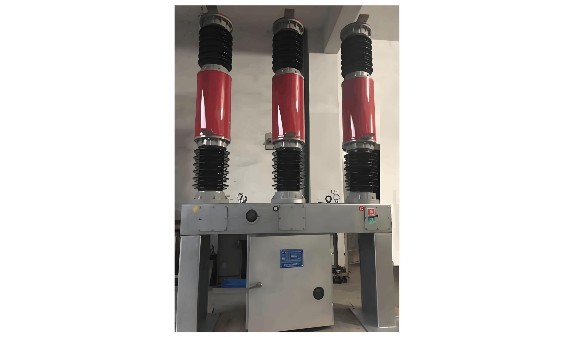
Fault Situation
In an 110kV substation, the A - phase porcelain sleeve of a 35kV circuit breaker burst. A part of the porcelain sleeve between the third shed and the lower flange fell off and flew out, and the internal insulating silicone grease leaked, forcing the equipment to shut down. On - site inspection of the faulty circuit breaker reveals that the direct cause of the fault is that the high - voltage conductor inside the supporting porcelain sleeve of the circuit breaker reacted with the porcelain sleeve, and the high - temperature arc generated by the discharge caused the porcelain sleeve to burst and the internal insulating silicone grease to flow out.
Sampling analysis
Macroscopic inspection
Two typical samples were obtained by sampling the shed porcelain bushing, and the inspection results are as follows:
Figure 2 shows the macroscopic morphology of sample 1taken on - site. There are large - area arc - burning traces on the inner wall of the porcelain sleeve of the sample. Along a section approximately 50.89mm in length, the fracture surface of the porcelain sleeve is mostly gray, and there are soot deposits on the surface of some areas. The section morphology is significantly different from other parts. The three parts of sample 1were inspected separately, as shown in Figure 2b, 2c, and 2d.
As can be seen from Figure 2b, the glaze on the inner wall of the sample has been burned and melted, forming numerous pits of various sizes. There is a smooth surface at the edge of the end - face, which is different from the glaze - melting mark, indicating the absence of glaze or uneven material. In Figure 2c, the red area at the root of the shed has a smooth surface, a hard texture, numerous small holes on the surface, with the back and bottom being grayish - white.
The red material is unevenly distributed, the surface is uneven, there is a local bulge, and the edge has an obvious black boundary with the porcelain body, suggesting that the material in this area is abnormal. Figure 2d is a locally enlarged image of the normal area of the shed section. It can be seen from the figure that there are many small holes on the surface of the sample, and the largest hole has a diameter of approximately 0.1mm.

Figure 3 depicts the macroscopic appearance of sample 2#. On the inner wall of the sample, there are signs of local arc burning and an unglazed area, as indicated in parts 1 and 2 of Figure 3a. Noticeably, the glaze at the arc - burned site features numerous pores, a result of the glaze melting after being subjected to high - temperature burning. At site 2 on the inner wall, there is a surface depression approximately 17.92 mm long and 2 mm deep. The color of this area matches that of the porcelain body, being grayish - white, which suggests that the surface lacks glazing, representing an original process defect.
Figure 3b shows the side macroscopic morphology of sample 2#. It is evident from the figure that a section of the sample's side has a round and smooth surface, contrasting with the rough normal fracture surface. This indicates that the porcelain body in this part is discontinuous, another original process defect.
From the macroscopic inspection results of the samples, it can be concluded that the faulty porcelain bushing exhibits several original process defects, including uneven material, a discontinuous porcelain body, an unglazed surface, and a large number of small holes.
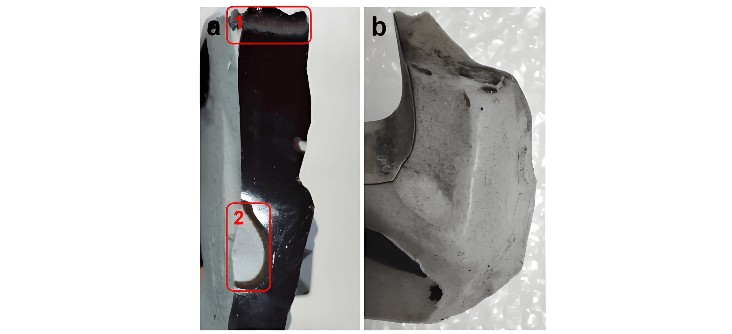
Scanning Electron Microscopy (SEM) Analysis of Microscopic Morphology
SEM analysis was conducted on samples from the normal section, red - colored area, smooth - surfaced region, and inner discharge surface of the porcelain bushing. The scanning microscopic images of the samples are presented in Figure 4.
As illustrated in Figure 4a, the sample from the normal section of the porcelain bushing displays a rough surface with directional fracture textures. A significant number of pores are evenly distributed across it, suggesting that the porcelain of the bushing is porous and has a relatively low density.
Figure 4b reveals that the sample from the red - colored area also features numerous pores. Compared to the normal - section sample, these pores are larger in size, less densely packed, and the porcelain density is relatively higher. This indicates non - uniform sintering of the porcelain material within the bushing.
From Figure 4c, it can be observed that the smooth - surfaced sample also contains a large number of pores, along with numerous uneven pits scattered across its surface. Despite this, the overall surface appears relatively smooth and flat, implying that the abnormal characteristics of this section pre - existed before the fracture occurred.
Figure 4d shows that the glaze on the discharge - cauterized surface is smooth but dotted with numerous bubbles and pits. These features are attributed to the release of gases during the melting process of the glaze, triggered by the high temperatures generated during the discharge event.
Scanning Electron Microscopy (SEM) Analysis of Microscopic Morphology
SEM analysis was conducted on samples from the normal section, red - colored area, smooth - surfaced region, and inner discharge surface of the porcelain bushing. The scanning microscopic images of the samples are presented in Figure 4.
As illustrated in Figure 4a, the sample from the normal section of the porcelain bushing displays a rough surface with directional fracture textures. A significant number of pores are evenly distributed across it, suggesting that the porcelain of the bushing is porous and has a relatively low density.
Figure 4b reveals that the sample from the red - colored area also features numerous pores. Compared to the normal - section sample, these pores are larger in size, less densely packed, and the porcelain density is relatively higher. This indicates non - uniform sintering of the porcelain material within the bushing.
From Figure 4c, it can be observed that the smooth - surfaced sample also contains a large number of pores, along with numerous uneven pits scattered across its surface. Despite this, the overall surface appears relatively smooth and flat, implying that the abnormal characteristics of this section pre - existed before the fracture occurred.
Figure 4d shows that the glaze on the discharge - cauterized surface is smooth but dotted with numerous bubbles and pits. These features are attributed to the release of gases during the melting process of the glaze, triggered by the high temperatures generated during the discharge event.
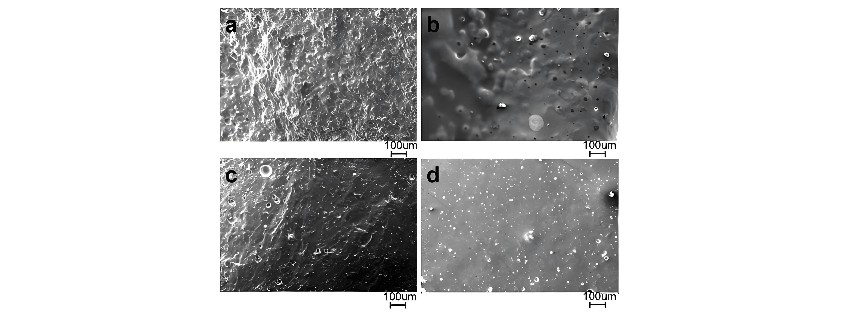
Through SEM micromorphology analysis, it can be concluded that the porcelain sleeve has inherent defects such as loose porcelain structure, low density, and abnormal cross - sections.
Energy Spectrum Analysis
As described above, energy spectrum analysis was carried out on the surface elements and their distributions at four different locations of the sample. Figure 5 illustrates a detailed example of the surface element distribution diagram. The elements on the surface of the samples from the normal section, smooth surface, and discharge part of the porcelain sleeve mainly consist of oxygen (O), silicon (Si), and aluminum (Al).
Overall, the element distribution on the surface of these samples is relatively uniform. However, the element distribution on the surface of the sample from the red - colored area is uneven. In the lower - right region of this sample, the contents of oxygen (O), aluminum (Al), and potassium (K) increase significantly, while the distribution of silicon (Si) elements remains relatively consistent. This indicates that during the sintering process of this region, the distribution of O, Al, and K elements was not homogeneous.
Meanwhile, a comparison was made of the main element contents of the four samples, and the results are presented in Table 1. The oxygen (O) element content on the surface of the normal - section sample is notably higher than that of the other three samples, whereas the silicon (Si) element content is lower. This suggests that the material composition varies unevenly across different parts of the porcelain sleeve sample.
The samples from the red region have a relatively high silicon (Si) content and the lowest oxygen (O) content. Additionally, a significant amount of copper (Cu) is detected on the surface of the inner - wall discharge part of the porcelain sleeve. This is due to the melting and evaporation of the bronze inside the porcelain sleeve at high temperatures during the discharge process, followed by sputtering and deposition on the inner surface of the porcelain sleeve.

Scanning Distribution of Surface Elements of Samples
Based on the energy spectrum analysis, it can be firmly concluded that during the sintering process of the porcelain sleeve, the distribution of various elements is highly non - uniform. This non - uniformity directly implies that the materials of different sections within the porcelain sleeve exhibit significant disparities.

Conclusion and Suggestions
Conclusion
Through macroscopic inspection, SEM micromorphology analysis, and energy spectrum analysis, it has been determined that the porcelain sleeve exhibits characteristics such as relatively loose structure, internal stratification, uneven composition, and the presence of micropores. Additionally, there are inherent defects on the inner surface of the porcelain sleeve, including local unglazed areas and subpar manufacturing process quality.
Due to these macroscopic and microscopic defects in the porcelain sleeve, during its long - term outdoor operation, external moisture and gases gradually penetrate into the sleeve. This infiltration leads to a degradation of the porcelain sleeve's insulation performance. Under the influence of the electric field, electrical discharge occurs between the internal conductor and the weak areas of the porcelain sleeve. The discharge generates local high temperatures within the porcelain sleeve and deteriorates the performance of the insulating silicone grease. Eventually, under the action of internal pressure, the porcelain sleeve bursts.
Suggestions
Porcelain sleeve manufacturers should enhance quality control during the firing process of porcelain sleeves to ensure consistent and high - quality product output.
Appropriate protective measures must be implemented during the transportation of porcelain sleeve products. This is crucial to prevent severe vibrations or collisions that could potentially damage the porcelain sleeves.
Product users are advised to strengthen the quality sampling inspection of the porcelain sleeves of incoming equipment. This practice ensures that the quality of the warehoused equipment complies with the required standards.
Close attention should be paid to the operational status of the batch of equipment. In particular, for equipment with existing silicone grease leakage or porcelain sleeve cracks, prompt power - outage maintenance and flaw detection should be carried out to avoid potential failures and ensure the safe and reliable operation of the electrical system.
Hey there! I'm an electrical engineer specializing in Failure and Maintenance. I've dedicated my career to ensuring the seamless operation of electrical systems. I excel at diagnosing complex electrical failures, from malfunctioning industrial motors to glitchy power distribution networks. Using state - of - the - art diagnostic tools and my in - depth knowledge, I pinpoint issues quickly. On this platform, I'm eager to share my insights, exchange ideas, and collaborate with fellow experts. Let's work together to enhance the reliability of electrical setups.


